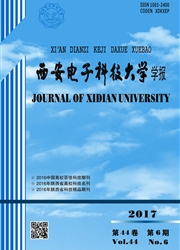

 中文摘要:
中文摘要:
提出了一种基于多稀疏特征空间的压缩感知图像恢复算法,将全变差最小化特征和分段自回归模型(PAR)残差系数的稀疏特征同时作为信号的联合稀疏特征约束,根据信号局部特性自适应地选取与图像特征相适应的特征空间,并建立了包含多项1范数和2范数混合优化的目标函数.为了求解该目标函数,采用了一种基于交替方向法的高效优化算法.实验证明,利用多空间稀疏特征的重构图像相比单个特征的重构图像,在客观质量和主观视觉效果上都有很大提升.对于图像信号在一定的采样率下,文中算法的峰值信噪比与全变差最小化方法和基于PAR残差系数稀疏算法的峰值信噪比相比,分别有7dB和1dB的提高.
 英文摘要:
英文摘要:
Most traditional compressed sensing(CS) reconstruction algorithms only exploit the sparsity of a natural signal in a single sparse space. However, since natural signals often exhibit spatially varying characteristics, the single space sparse representation fails to well characterize the local signal structures. The mismatch between sparse representation in the single space and the varying local structures make the reconstruction algorithms fail to exploit the local sparsity, leading to low reconstruction quality. In this paper, we propose a new image signal reconstruction method based on multiple sparse spaces (MSS) to overcome this defect of the CS reconstruction algorithms in the single space, where a signal is adaptively characterized by the total variation(TV) model or the piecewise autoregressive(PAR) model according to its local structures. The objective function of the proposed MSS-based CS reconstruction is then formulated as a multiple l1-norm and l2-norm minimization problem. To efficiently solve the proposed objective function, an alternating direction method(ADM) is used: Experimental results show that compared with the single space methods the proposed MSS-based reconstruction method achieves a much better visual quality and a higher PSNR. The PSNR improvements over TV and AR based methods can be up to 7 dB and 1 dB, respectively.
 同期刊论文项目
同期刊论文项目
 同项目期刊论文
同项目期刊论文
 Asymptotic Spectral Efficiency of Digital Transmission via Overcomplete Frames With Discrete, Finite
Asymptotic Spectral Efficiency of Digital Transmission via Overcomplete Frames With Discrete, Finite A sparse representation-based deployment method for optimizing the observation quality of camera net
A sparse representation-based deployment method for optimizing the observation quality of camera net Narrowband Ultrasonic Detection With High Range Resolution: Separating Echoes via Compressed Sensing
Narrowband Ultrasonic Detection With High Range Resolution: Separating Echoes via Compressed Sensing A Linear Combination-based Weighted Least Square Approach for Target Localization with Noisy Range M
A Linear Combination-based Weighted Least Square Approach for Target Localization with Noisy Range M 期刊信息
期刊信息
